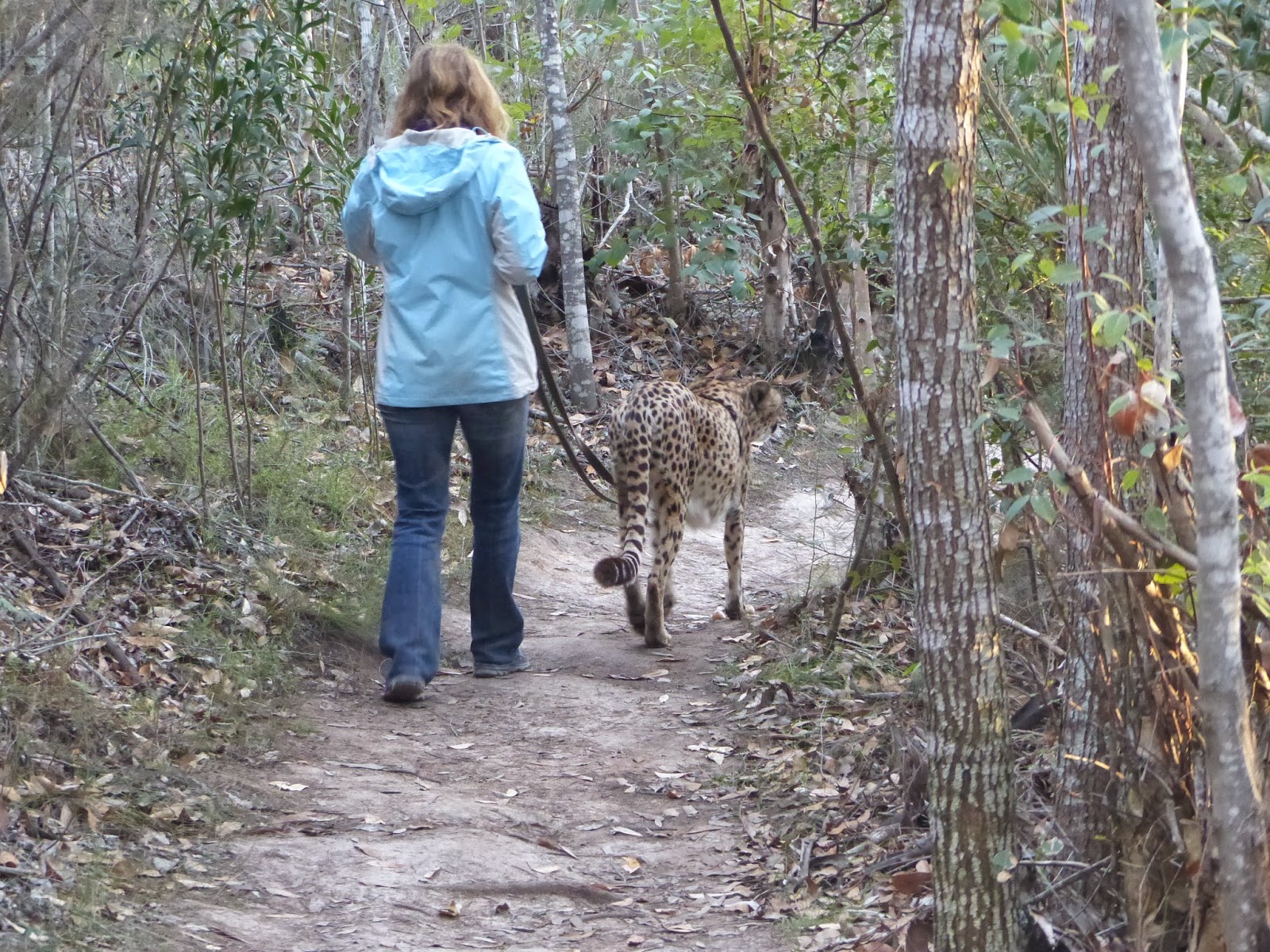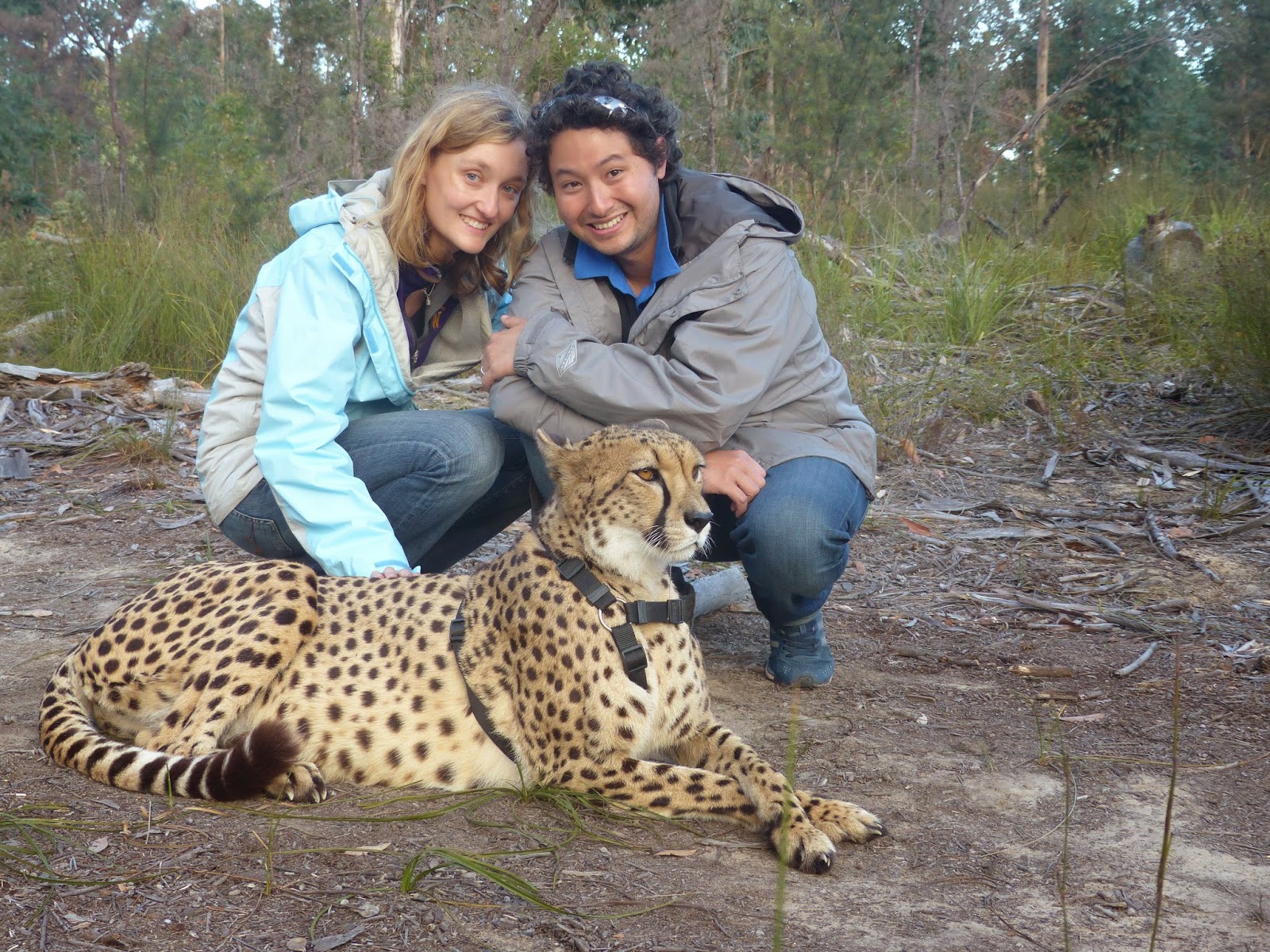After Addo, we continued west
on the N2 (aka the highway of death) to Knysna, part of South Africa’s Garden
Route. Steph had determined that this
would be the perfect Garden Route stop because it included both whale watching
AND cheetah walking.
 En route, we stopped for a
short hike at Tsitsikamma National Park, where the Storms River empties into
the Indian Ocean at Storms River Mouth.
Upon reading the description of the suspension bridges hanging
precariously over the mouth, Giorgio was a bit concerned about the safety of
our hike.
En route, we stopped for a
short hike at Tsitsikamma National Park, where the Storms River empties into
the Indian Ocean at Storms River Mouth.
Upon reading the description of the suspension bridges hanging
precariously over the mouth, Giorgio was a bit concerned about the safety of
our hike.
On to the whales and
cheetahs! Our first full day in Knysna
was reserved for whales and the second for cheetahs. Given our failure to see a single whale on
our last whale-watching trip (Iceland 2012), we were a bit concerned about
dedicating another day to this possibly fruitless endeavor. However, the guide repeatedly assured us that
he had seen whales on every outing since May.
It turns out this was not just a marketing ploy – we were treated to the
sight of two humpback whales that were as entertained by our boat as we were by
them. Repeatedly swimming back and forth
under our small vessel, they spouted and breached alongside us for over an
hour. When we saw how close these large
animals came to the boat, which was already bobbing up and down some fairly
sizable waves, we understood why we had been forced to wear unfashionable
bright orange life vests for the duration of the trip.
If the possibility of a
capsized boat wasn’t enough excitement, we visited the Tenikwa Wildlife Awareness and Rehabilitation Centre the following day for our planned sunset cheetah walk,
which Steph had been eagerly anticipating for over a year. Before heading out on our walk with "Chester" and "Zimbale," we had the chance to see some of the large and small cats that
eluded us on our game drives (in order below, caracal, serval, and leopard). Leopards
aren’t a myth after all! Since we are in
South Africa and not the US, we even went into the cage with the servals and
the African wild cats. (Note: African wild cats look pretty much like
domestic cats and are not as fearsome as the name implies.) After a close look at the African wild cats,
we are convinced Steph was feeding a pair back at our cottage in Kosi Bay.
Unlike pony trekking in Lesotho, there are some rules for walking a cheetah in South Africa.
1. If the cheetah starts to run, drop the leash
since you obviously can’t keep up with the cheetah running 120 km/hr.
2. Don’t stare at the cheetah in the eyes as he/she will take your stare as a sign of aggression.
3. Let the cheetah walk in whatever direction it wants (on the path, into the trees, down a steep hill).
4. If the cheetah doesn’t want to walk anymore, don’t walk anymore – just stop and hang out.
5. If your cheetah growls at you, stop petting it.
6. Don’t walk directly in front of the cheetah (presumably because it might eat you).
Note for Ephraim: If the cheetahs can learn to walk on a leash,
you should be able to handle it.
Our time in Knysna
resembled a visit to Cape Cod in the late fall – we were staying in a gorgeous
setting on the ocean, deserted without the summertime crowds. (It was a good thing that we had our cold
weather gear from Lesotho though.) The
town itself is situated on a picturesque harbor and our cottage was tucked away
on the far side of the harbor with a lovely beach just down the hill.
After weeks of drinking mass-produced beer from SAB (South African Breweries, which also owns Miller), we were excited to visit the first two of hopefully many craft breweries on our trip. We stopped at Mitchell’s (the country’s oldest craft brewery – the same age as Steph) and Robertson Brewery (which, like most of the craft breweries here, opened within the last couple years).















No comments:
Post a Comment